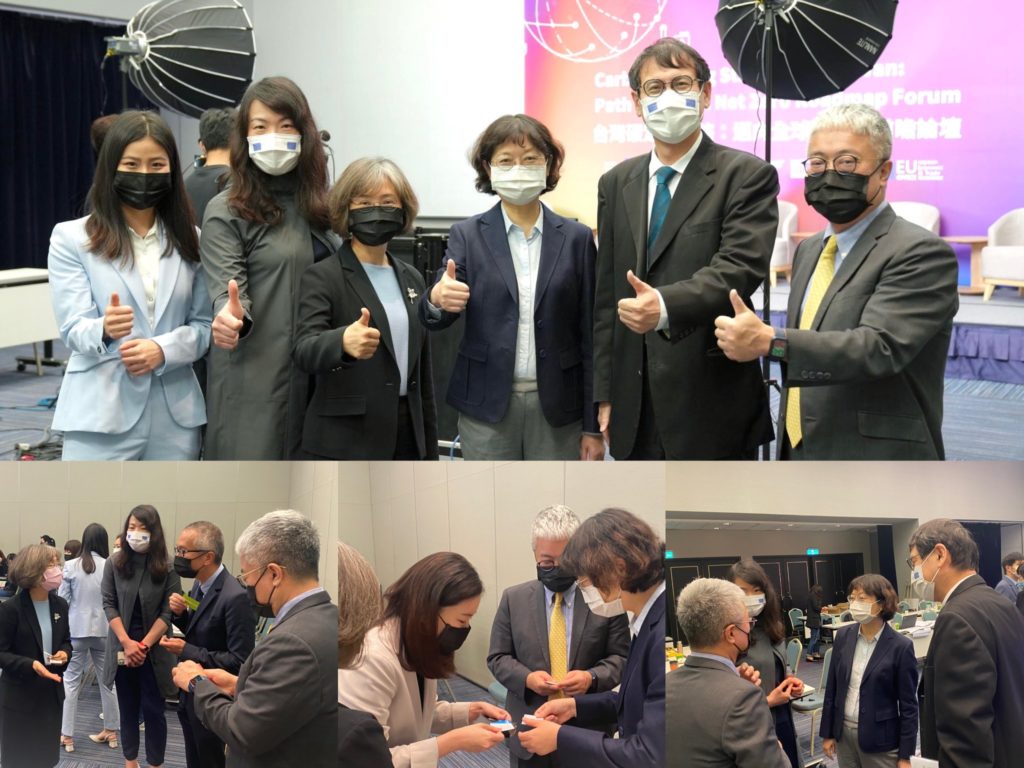[Event Report] Carbon pricing strategy of Taiwan: path to global net zero roadmap「台灣碳定價策略:邁向全球淨零」 論壇
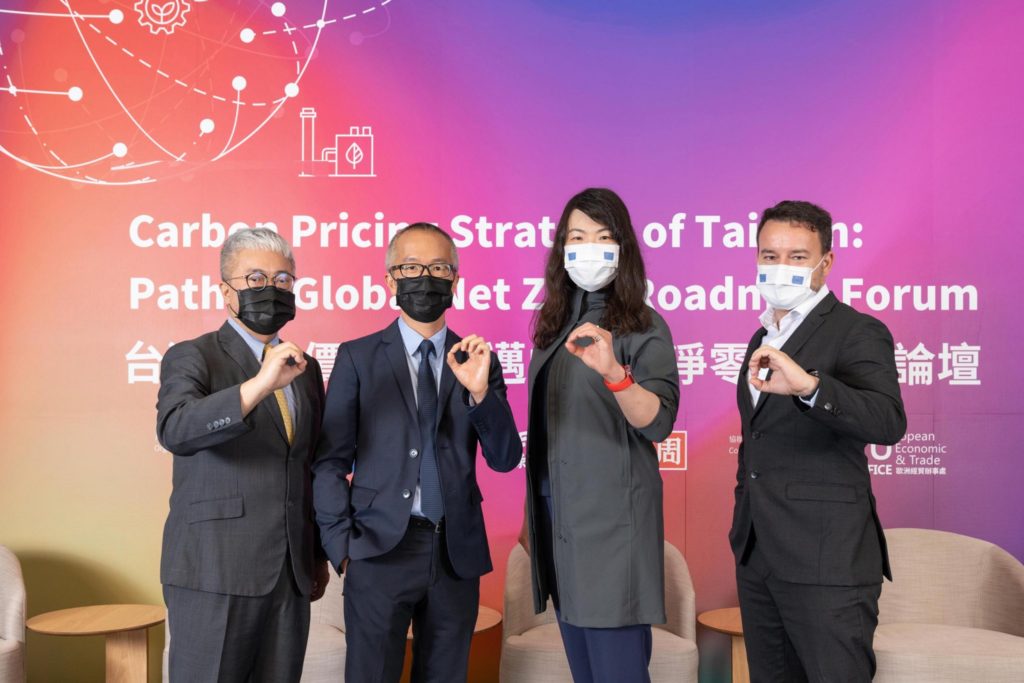
(L-R: Raime Chu, General Manager of Business Weekly Group; Pang Cheung Sze, Executive Director at Greenpeace East Asia; Sammy Su, Director of ECCT LCI; Guillermo Martinez, Deputy Head of EETO Office )
- Photo Gallery: Facebook
- Press Coverage: PDF
- Live-stream Video: https://bw.businessweekly.com.tw/event/2022/ECCT-LCIXGreanpeace/live.html
On 24 May, the 2022 Carbon pricing strategy of Taiwan: path to global net zero roadmap forum (台灣碳定價策略:邁向全球淨零 論壇) was made a great success by the ECCT’s Low Carbon Initiative (LCI) together with Greenpeace 綠色和平, Business Weekly 商業周刊 and co-organised by the European Economic and Trade Office 歐洲經貿辦事處. Distinguished policy and expert speakers from the World Bank 世界銀行, WEF 世界經濟論壇, EU 歐盟, PwC 資誠, Atlas Copco 阿特拉斯科普柯, Delta Electronics 台達電子, Executive Yuan行政院能源減碳辦公室, EPA Climate Change Office 環保署氣候變遷辦公室 provided insights of global carbon pricing strategies and pointed out how how Taiwan can prepare for the challenges facing international carbon tariff set by the EU and other countries. The key focuses included carbon pricing floor (CPF, 碳底價) for different countries could speed up the world's transition to net zero, and industry will maintain competitiveness by enhancing energy efficiency and conducting the internal carbon pricing (ICP, 內部碳定價). Over 550 participants attended online.
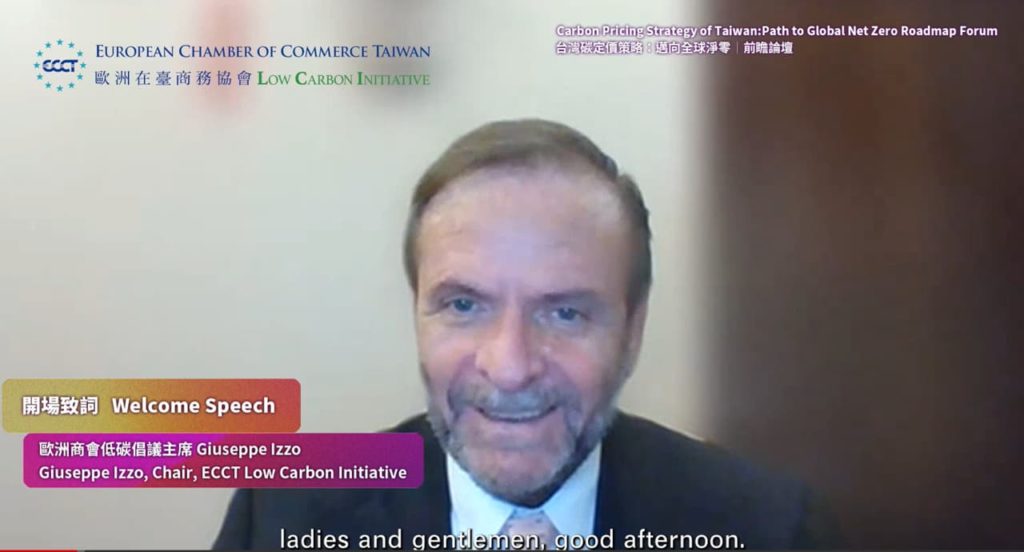
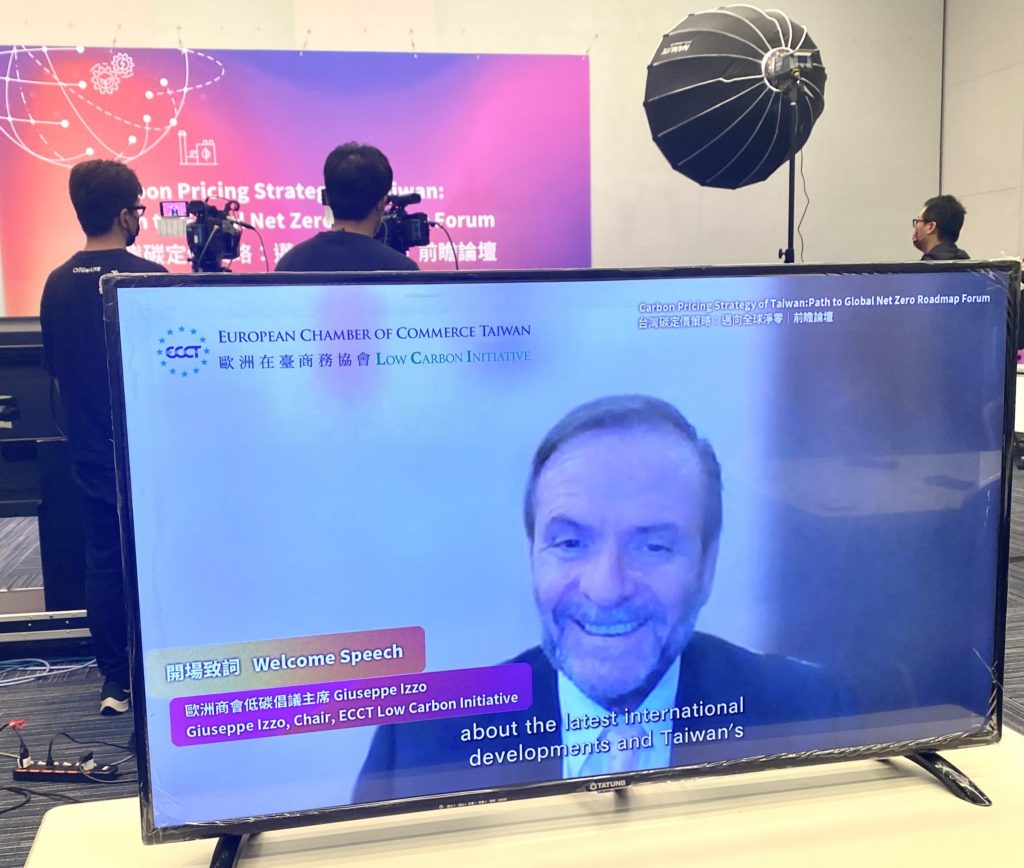
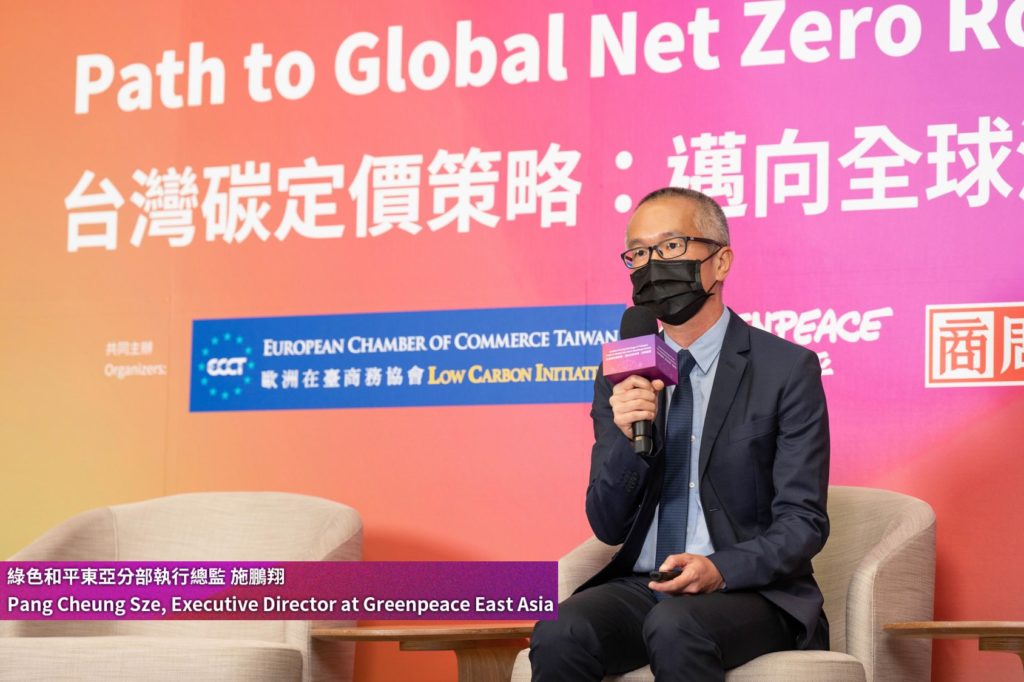
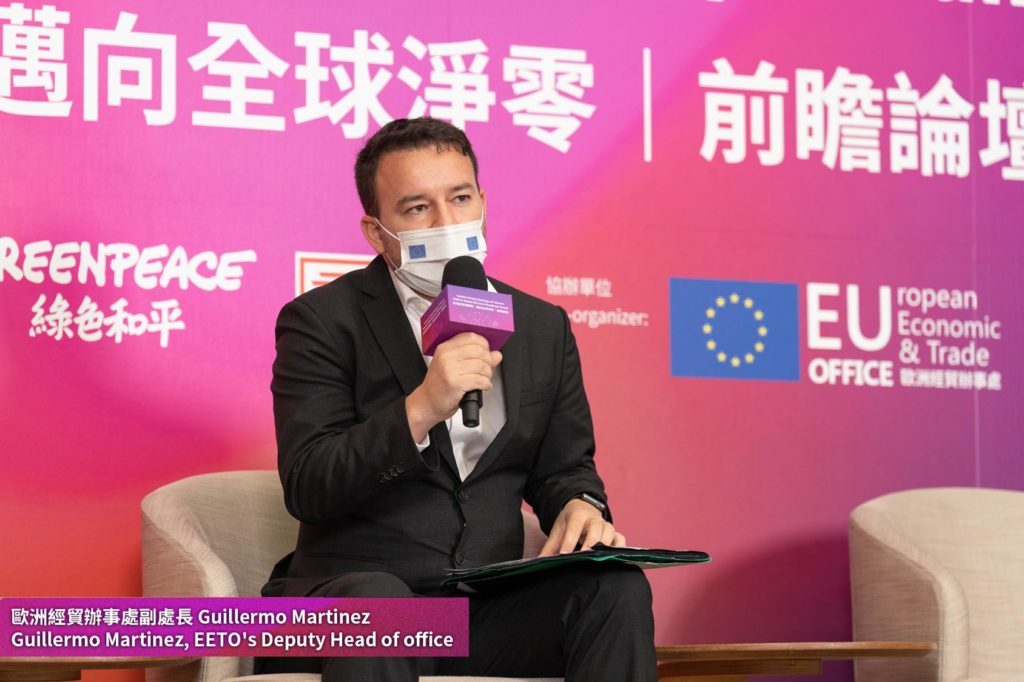
At the event, opening remarks were made by ECCT LCI Chair Giuseppe Izzo (歐洲商會-低碳倡議行動主席 尹容), Sze Pang-cheung, Executive Director of Greenpeace East Asia (綠色和平東亞分部執行總監 施鵬翔), and Guillermo Martizez, Deputy Head of the EETO (歐洲經貿辦事處副處長).
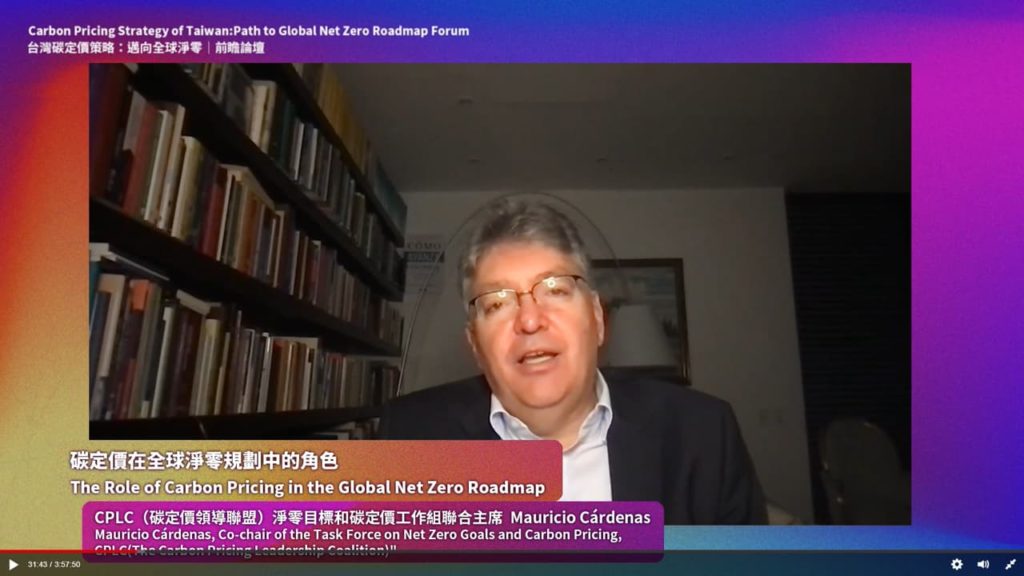
In his presentation, Mauricio Cardenas, Co-chair of the Task Force on Net Zero Goals and Carbon Pricing (CPLC) of the World Bank (世界銀行碳定價領導聯盟淨零目標和碳定價工作組聯合主席) and a scholar at Columbia University, spoke about the role of carbon pricing in the global net zero roadmap. He reported that the task force analysed the role of carbon pricing and delivered the following key messages:
- We will achieve net zero when human-caused GHG emissions have been reduced to the absolute minimum levels feasible and any remaining residual emissions are balanced by an equivalent quantity of human-caused removals that are permanently stored so that emissions cannot be released into the atmosphere;
- The scale and urgency of emissions reductions needed by both countries and the private sector mean that we can no longer take action only where emissions reductions are low cost or in a piecemeal fashion. While carbon pricing is not a silver bullet, it can help. In the absence of government action, corporations can use internal carbon pricing to do a cost-benefit analysis and take action unilaterally;
- Carbon pricing, including international cooperation through carbon markets should be included in the arsenal of measures to enable the achievement of net zero targets;
- It is important to make sure that carbon credits are used in a way that prevents double counting;
- Corporations need to look at the emissions on the whole value chain (known as scope 1, 2 and 3);
- Net zero criteria should be in incorporated into all investment decisions, including those of financial development institutions;
- We also need to address energy poverty at the same time and should generate jobs and provide other benefits for disadvantaged segments of the population;
- Transparency is essential in communicating how to reach net zero;
- We need to have a clear and transparency of the instruments to be used and for how long.
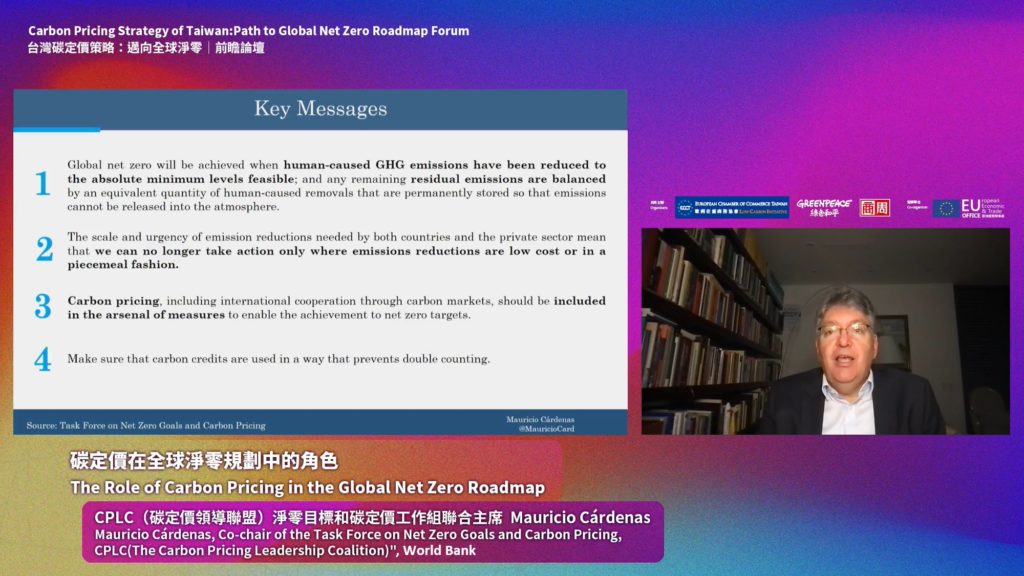
Finally, He concluded that net zero is within reach, but we need to recognise that emerging countries have other priorities that need to be met and cannot be disregarded at the expense of reaching net zero.
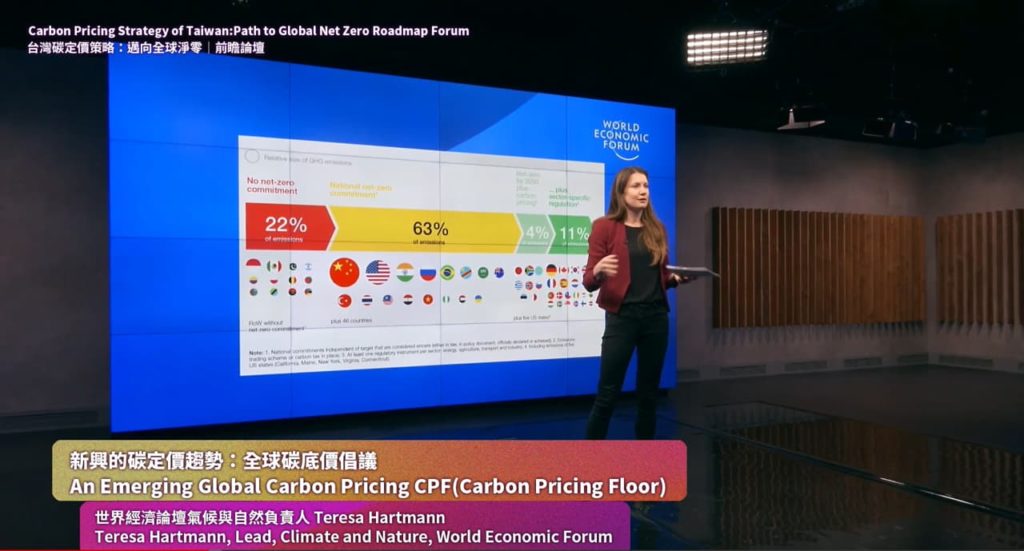
Teresa Hartmann, Lead for Climate and Nature at the World Economic Forum (世界經濟論壇氣候與自然負責人), spoke about global carbon pricing. Using the example of manufacturing a car, she noted that producing one tonne of steel releases two tonnes of carbon emissions. So, when calculating the price of the car, this should be taken into account. When carbon was priced at only US$16 per tonne, this would only add a small cost to the final price of the car. However, as the price of carbon rises, it begins to make a significant difference in cost to the consumer. It also gives an incentive to producers reduce the amount of emissions in the manufacturing process.
Since different countries price carbon at different rates, this leads to price distortions. There are also concerns about how carbon pricing will affect GDP and individual companies.
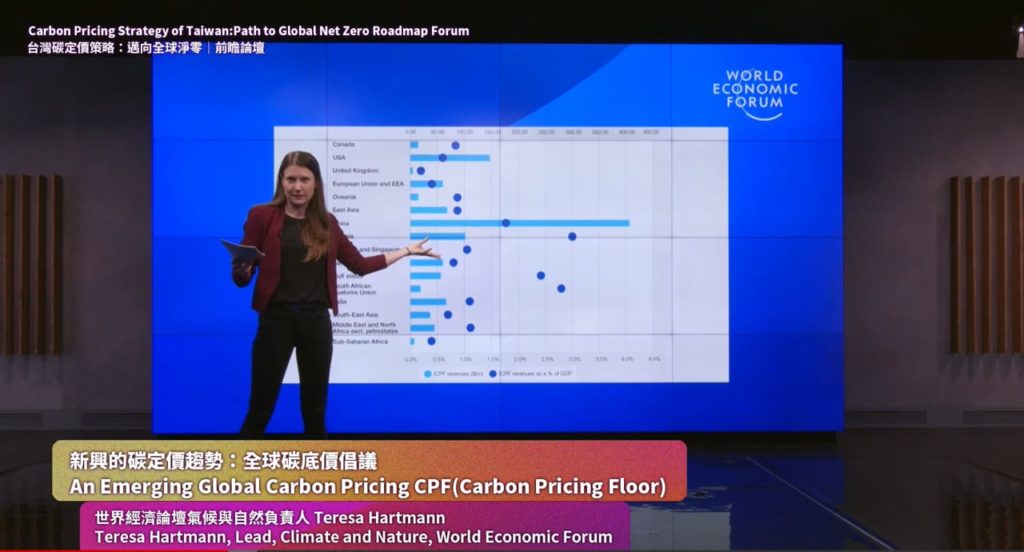
What is the right price given that our economies are so diverse? According to the OECD, the minimum bar should be €30 per tonne and raised to €60 by 2030 in order to reduce emissions and spur innovations. She noted that the price of EU carbon permits traded on the EU’s Emissions Trading System (ETS) is already much higher than these levels. The price rose to close to €100 in recent weeks (although it has since fallen to around €80). She expressed the view that prices will continue to rise in the future as the energy transition proceeds. The IMF has proposed a global carbon price floor three tiers: US$25 for low-income countries, US$50 for middle income countries and US$75 for high income countries. Based on WEF analysis, if middle income countries participate in carbon pricing floors, the benefits would be four times that if just rich countries participated. For carbon pricing to be effective, the world’s biggest emitters (China, the United States, India, the EU, Russia, Japan and Canada) must participate.
When the EU’s Carbon Border Adjustment Mechanism (CBAM) is implemented, there will no longer be a benefit to importing products, such as steel and cement from countries where it is cheaply produced. Moreover, carbon pricing can actually spur innovation (there is evidence that it results in higher spending on R&D). There are first mover advantages. Recent research showed that companies that took action early on climate change, are reaping the benefits in terms of better access to capital, higher returns on investment and higher employee retention.
The speaker concluded that we need better carbon market coverage, the impact of carbon pricing on GDP will be lower than anticipated and having a low carbon price is no longer an advantage. Finally, there is no alternative to decarbonisation. We are track for a global rise in temperature of 3 degrees Celsius, which will have devastating consequences.
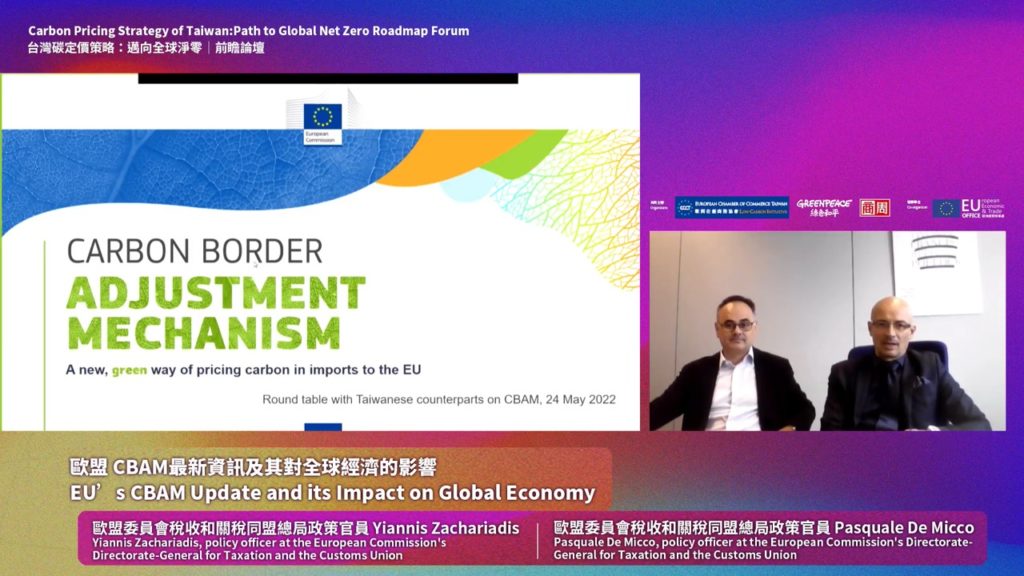
In their presentations Pasquale De Micco and Yiannis Zachariadis, Policy Officers at the European Commission’s Directorate-General for Taxation and the Customs Union (歐盟委員會稅收和關稅同盟總局政策官員), gave an update on the CBAM and its impact on the global economy. They began with an introduction to CBAM for those not familiar with it. They noted that third countries will not have to pay twice if they can demonstrate that the price of carbon is embedded.
The first five sector targeted initially (iron and steel, cement, fertilisers, aluminium, and electricity generation) will not have much of an impact on Taiwan since these sectors do not account for a large portion of Taiwan’s exports. The first three years (2023-2025) will just require reporting while CBAM will begin to be implemented in 2026 and be gradually phased in over the next 10 years until fully implemented by 2035. In terms of international coordination, the EU believes that CBAM complements other international level efforts but is being implemented early given the urgent need for action to address climate change. Moreover, the EU complies with international rules. However, there are some differences between the ETS and CBAM. ETS is applied to installations in the EU while CBAM is for imported products. ETS is capped while CBAM is not. As CBAM certificates are theoretically unlimited, tradability is limited and can be bought back.
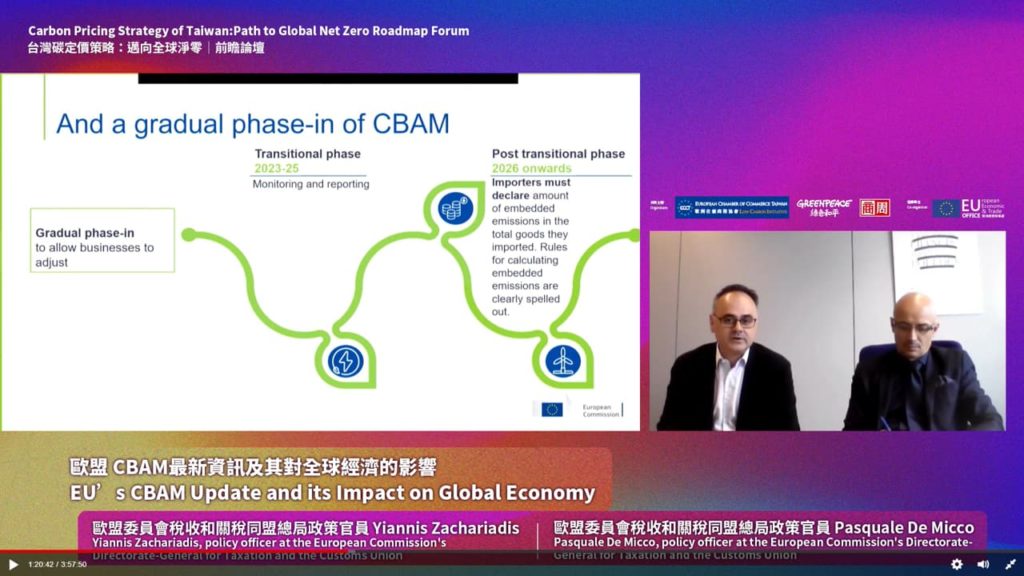
The system is internationally open which will allow exporters of clean products to pay less than exporters of dirty products. There are special rules for electricity. CBAM targets are companies, not countries.
The position of the European Council, adopted on 15 March, slightly alters the position of the European Commission in certain areas. Firstly, it proposes increased centralisation at the EU level of various tasks relating to the governance of CBAM. There will be a central registry instead of 27 national registries. It also introduces a ‘de mimimus’ clause exempting small consignments of goods from the application of CBAM. The European Parliament has not yet released its final position. Once this has been released, there will be further negotiations between the Parliament, Council and Commission.
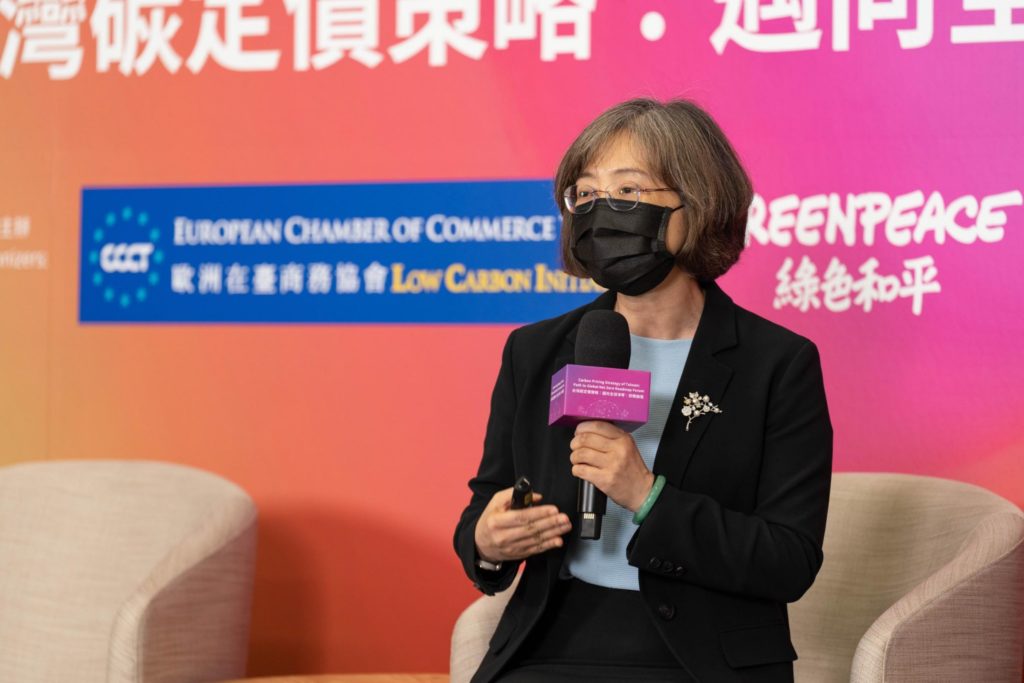
Eliza Li, Leader of Sustainability and Climate Change Services at PwC (資誠永續發展服務公司董事長 李宜樺) spoke about how government and corporations should prepare for net zero.
The government has already made public its plan for achieving net zero. She said that she hoped that financial institutions would prioritise funding to those focused on sustainability as this would be a great enabler for achieving the transition. The cost of carbon emissions is rising. 61 countries, accounting for more 22% of global carbon emissions, are implementing carbon pricing mechanisms. One international organisation said that the carbon price should be set at US$125 per tonne. From 2026-2030, the carbon price will rise. Individual companies need to prepare in advance by using internal carbon pricing (ICP) as a tool to conduct stress test and for making investment decisions.
Over the past five years, ICP has increasingly been used by global corporations and achieved great results in facilitating investments. There are two main carbon pricing is done: a shadow price and a carbon fee. A shadow price is good tool to help make investment decisions while carbon fees can be used to set up funds to be used for things like purchasing renewable energy or carbon emission offsets. She cited analysis of Microsoft, which set its ICP at US$15 per tonne and implemented a system internally and also tried to implement it across the value chain with their partners.
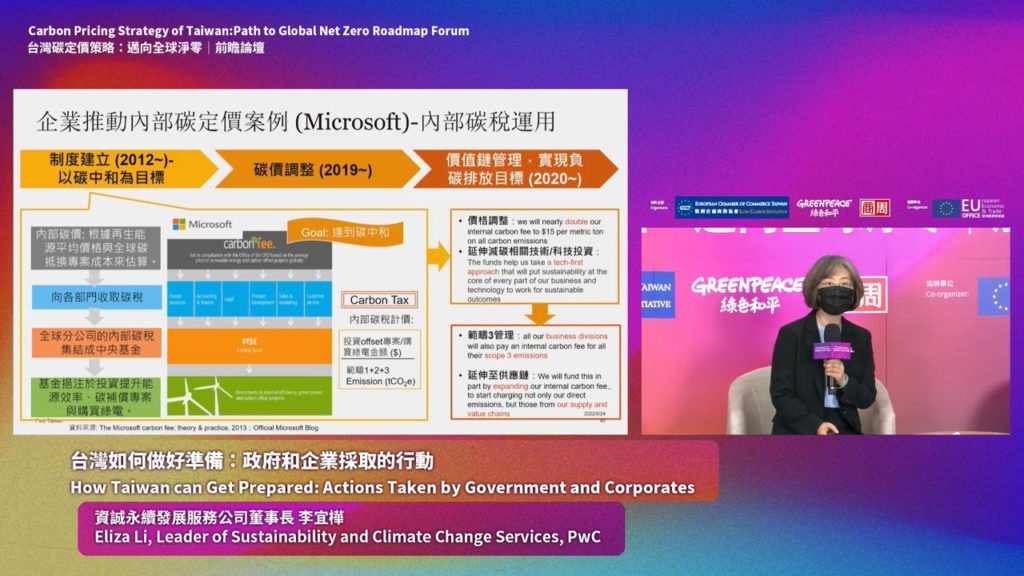
AUO is another example. The company ICP to make investment decisions. They calculated how long it would take to recoup investments as well as considering the energy savings and carbon reduction savings from the investments.
Tetra Pak, the drinks packaging company, also used ICP to guide investment decisions. The company revises its carbon prices twice a year. Since air freight is the main source of the company’s carbon emissions, they implemented internal policies to limit air freight and imposed an additional price for using air freight.
ICP can also play a role in M&A because it can assess the carbon emissions of the acquisition target. This is important for companies to assess their future carbon footprint if they go ahead with acquisitions. ICP can also help in decisions to purchase more efficient equipment, pursue more innovative technology, and make investments aligned with carbon targets. In addition, ICP can help in making supply chain decisions or even change assessments of a company’s own performance. The policy must be clearly communicated internally. Implementing ICP can also help to improve brand image.
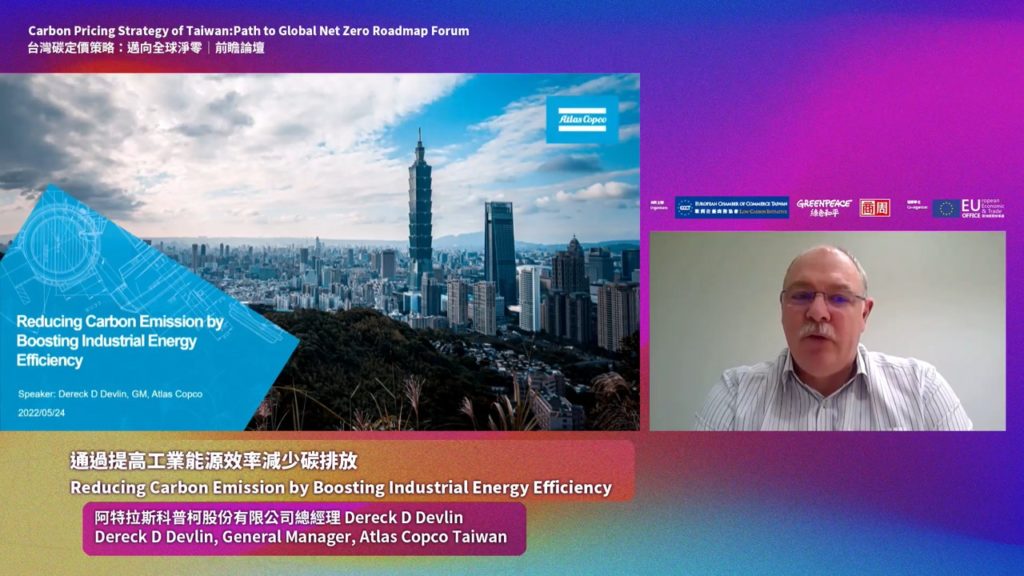
In his presentation, Dereck Devlin, General Manager of Atlas Copco Taiwan (阿特拉斯科普柯股份有限公司 總經理) spoke about reducing carbon emissions by boosting industrial energy efficiency. In its own operations, the company is switching to renewable energy and the use of EVs. By using their equipment, Atlas Copco is also helping its customers to reduce their emissions. According to Devlin, 10% of the global average power produced is to run air compressors in factories. Today, there are energy efficient ways to produce compressed air. The company’s air compressors are 30% more efficient than they were 20 years ago, and some can even be 50% more efficient. One kilowatt of compressed air requires 8kW of power to produce. The energy cost represents 70% of the total lifecycle cost of a compressor. That is why improving energy efficiency can save a lot of money as well as cut emissions. A 30kW air compressor running 24 hours a day consumes 262MWh of electricity, costs NT$76,300 and generates 182 tonnes of CO2 per year. You would need 1,200 trees to absorb that amount of CO2.
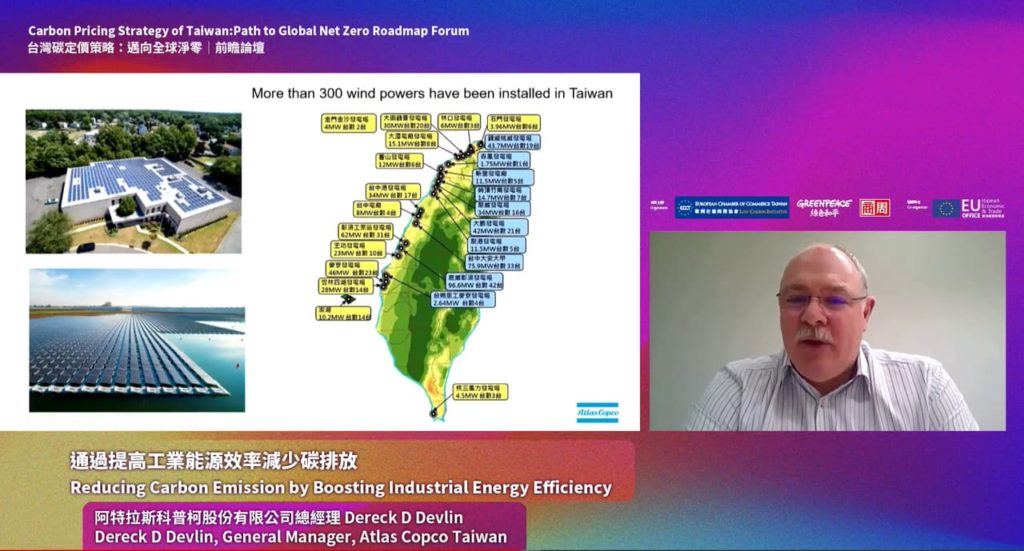
The energy that is used in an air compressor produces heat, which is often wasted. Atlas Copco has an energy recovery system to pass the heat through water, which can be used in facilities that need hot water for industrial processes, building heating or other uses. Air leaks in older systems wastes energy, which is why compressors need regular maintenance.
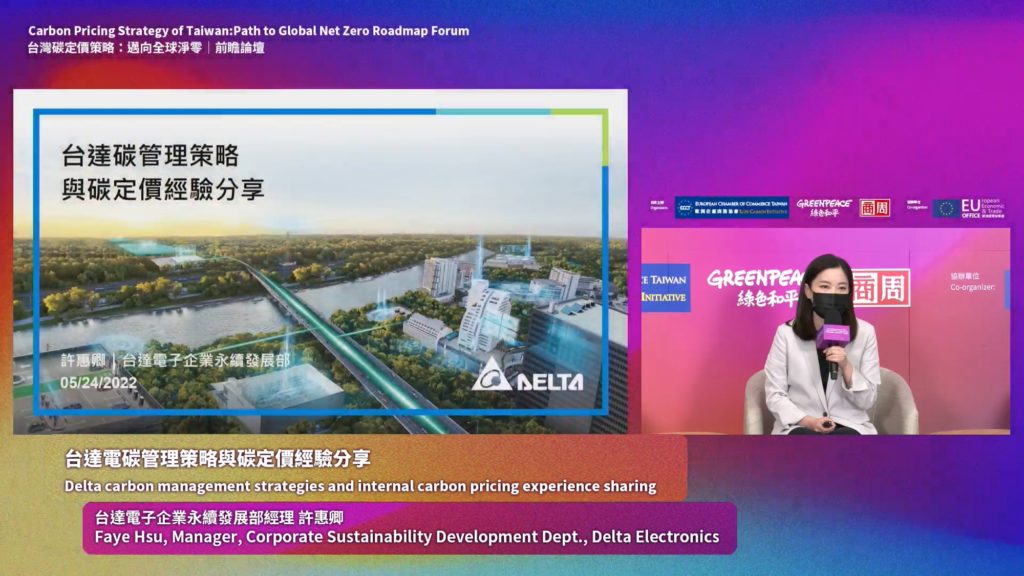
In her presentation, Faye Hsu, Manager of the Corporate Sustainability Development Department from Delta Electronics (台達電子企業永續發展部經理 許惠卿) spoke about Delta’s low carbon transition through various initiatives, including carbon pricing. Starting in 2015, Delta has committed to significant carbon reduction targets including a 56% reduction. Since then, it has committed to getting 100% of electricity from renewable sources by 2030, to only use EVs by 2030 across all of its locations globally and to reach net zero by 2050. The main strategies include improving energy efficiency, such as green buildings. The company has also installed EV charging spots at its facilities to encourage staff to use EVs.
According to Hsu, the company’s carbon intensity was reduced by 71% last year, reaching its target earlier than scheduled. The company achieved this via energy efficiency, green buildings and using renewable energy. The company has established working groups and set KPIs internally and introduced 2,500 energy saving initiatives, which have reduced emissions by 240,000 tonnes. Since 2006, the company has committed to making every new building green and the company has built or donated 30 buildings since then.
The company’s emission reduction numbers have been certified by a third party. Besides internal initiatives, the company’s green products also help its customers to achieve their carbon reduction goals. The company’s internal carbon pricing (ICP) has helped to support carbon reduction efforts and manage carbon use. Delta set a high carbon price after consulting experts and international report considering internal and external factors. The company looked at all locations to identify the highest cost. Based on this, it decided to set the price at US$300 per tonne. Every operation pays a fee for its emissions which are put in a fund. Delta has used the money from carbon pricing to support energy management internally, paying for renewable energy and R&D in new technological innovations. All business units can tap into funds if they come up with effective carbon reduction projects. Upon approval, they can use money from the fund. The strategy is promoted across the value chain, including scope 2 and 3. Partners should first take inventory after which Delta shares best practices and helps them evaluate risks. The company follows international standards, works with suppliers and customers.
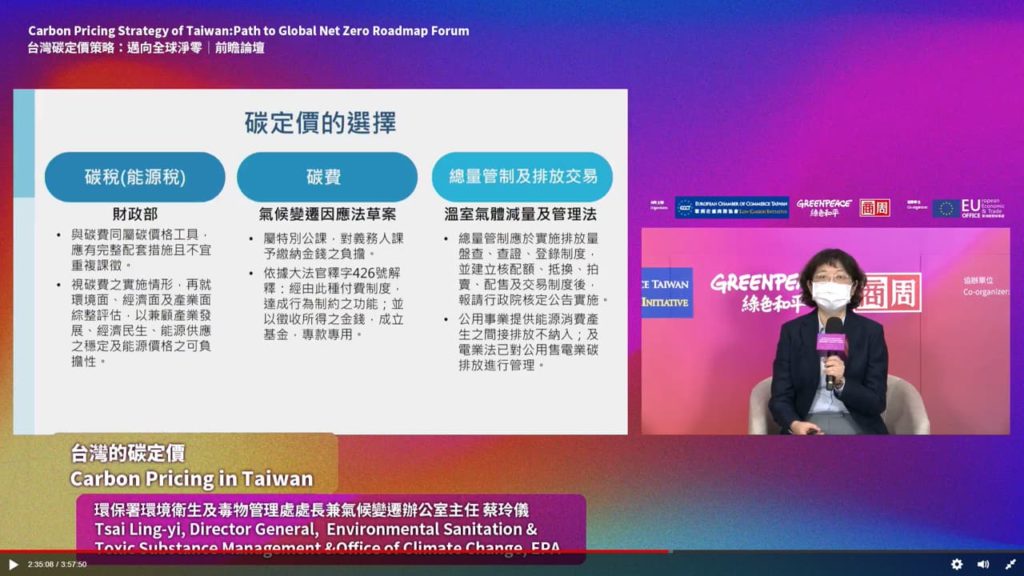
Dr. Tsai Ling-yi, Director-General of the Executive Yuan’s Office of Climate Change (行政院環保署 氣候變遷辦公室主任 蔡玲儀博士) began with a presentation on carbon pricing in Taiwan. A lot of attention has been focused on 2030 and the government is in the process of determining 2030 goals. It will include petrochemical, cement, and steel industries and those that use more than 250,000 tonnes of fuel. New legislation will integrate carbon fees, starting with targeting major emitters. Funds raised will be spent on R&D in reduction technologies and facilitate low carbon development.
In addition to the carbon fee, the new legislation will have efficiency standards, voluntary reductions, and a carbon credit system, use carbon footprint accounting as well as carbon sequestration. World Bank guidelines say that carbon pricing is important but not the only tool. Other measures are important and discussions on these will continue.
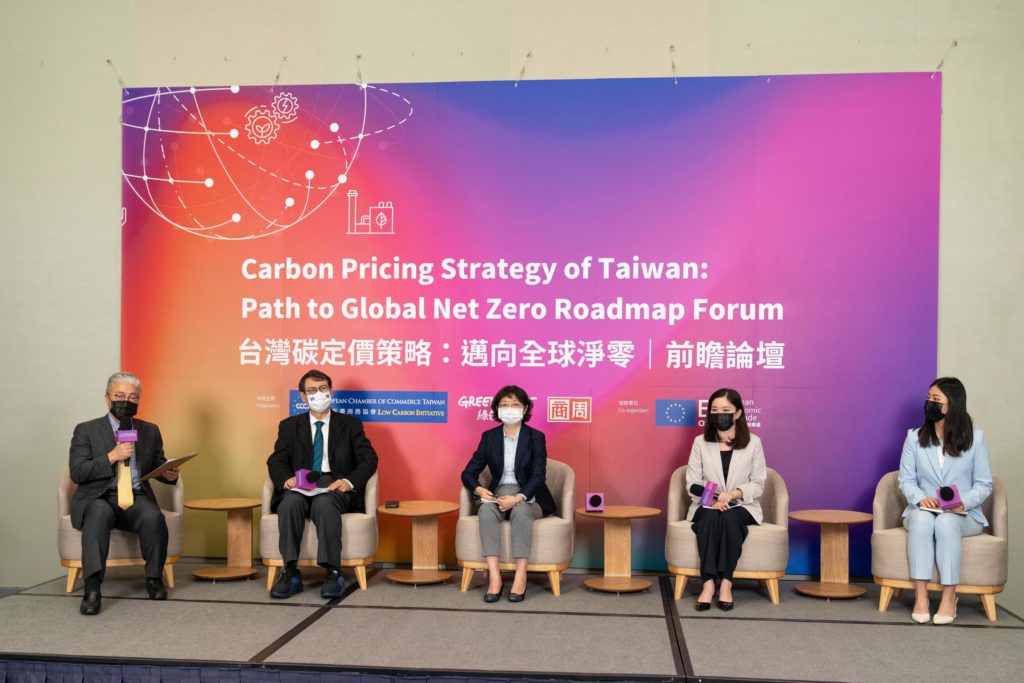
(L-R: Raime Chu, General Manager the Business Weekly Group 商周集團總經理 朱紀中; Dr Lin Tze-luen, Deputy Executive of the Office of Energy and Carbon Reduction 行政院能源及減碳辦公室副執行長 林子倫; Dr. Tsai Ling-yi, Director-General of the Executive Yuan’s Office of Climate Change行政院環保署 氣候變遷辦公室主任 蔡玲儀博士; Faye Hsu, Manager of Corporate Sustainability Development Dept., Delta Electronics 台達電子企業永續發展部經理 許惠卿; Tracy Cheng, Climate & Energy Campaigner from Greenpeace Asia 綠色和平氣候能源專案主任 鄭楚忻)
Panel discussion
The forum ended with a panel discussion moderated by Raime Chu, General Manager the Business Weekly Group (商周集團總經理 朱紀中). Panellists included the speakers and Dr Lin Tze-luen, Deputy Executive of the Office of Energy and Carbon Reduction (行政院能源及減碳辦公室副執行長 林子倫), Faye Hsu, Manager of Corporate Sustainability Development Dept., Delta Electronics (台達電子企業永續發展部經理 許惠卿), and Tracy Cheng, Climate & Energy Campaigner from Greenpeace Asia (綠色和平氣候能源專案主任 鄭楚忻).
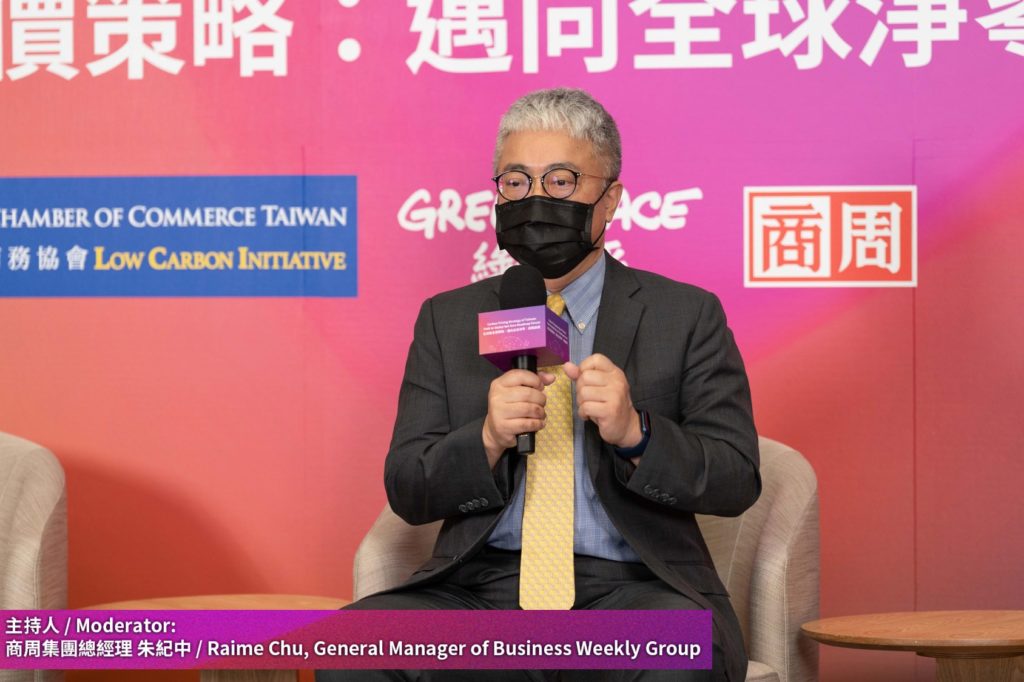
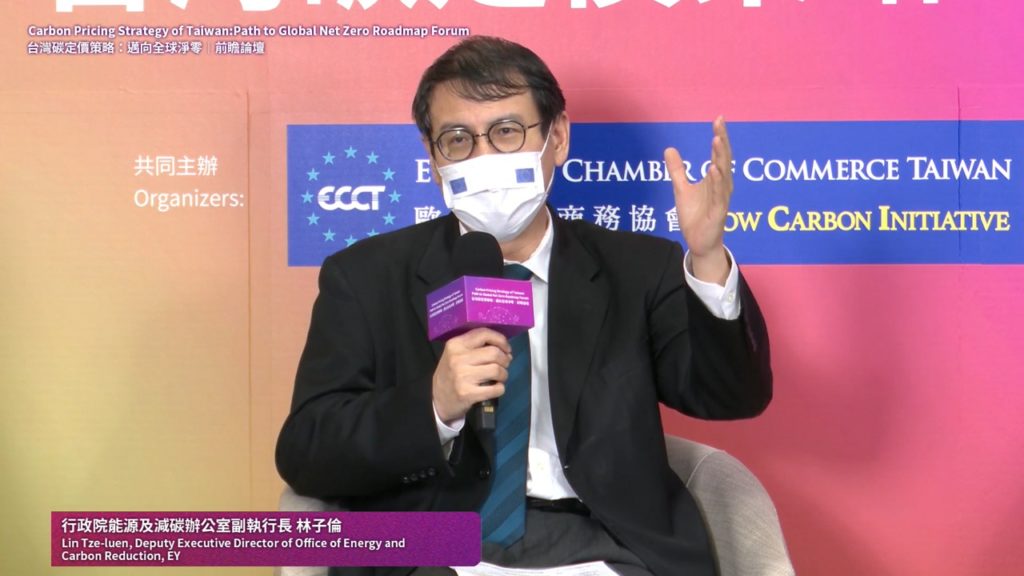
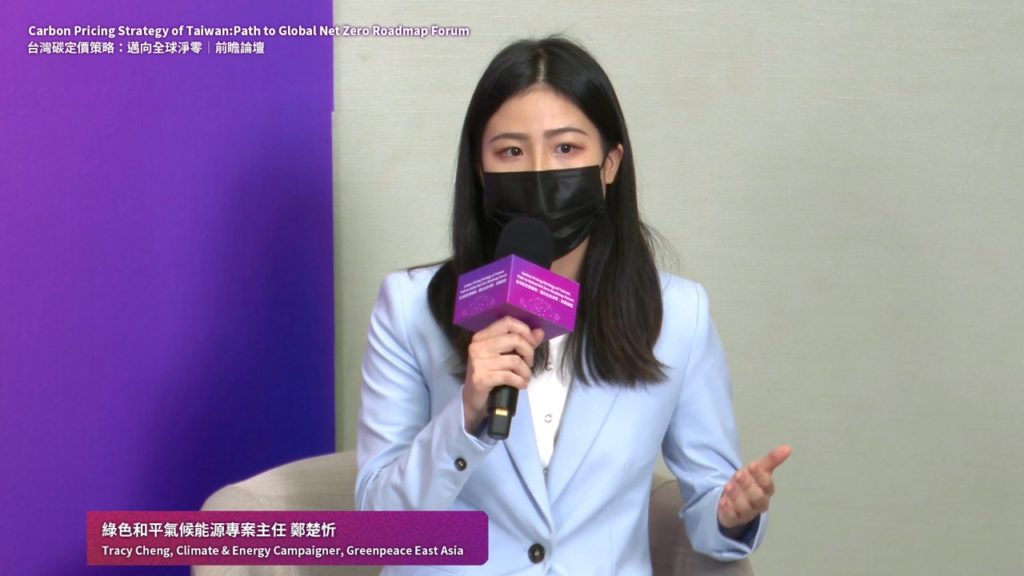
During the session Dr Tsai reported that the Climate Change Response Act review process in the Legislative Yuan began on 11 May. Some amendments have since been made. The EPA hopes the bill will be passed by the end of the year. The EPA is also formulating regulations to govern carbon pricing, which is targeted to be implemented in 2024. Tsai said that companies should begin by conducting carbon emission inventories. The next step is to reduce emissions. The pricing mechanism will start with major emitters, defined as companies that burn 25,000 tonnes of fuel or more per year. Companies that submit plans can enjoy discounts, but this will only be given as an incentive for companies to reduce emissions. Other companies that fall below the threshold should still start to prepare since they may be asked to do so by their large customers.
Since the government charges a fee, some of the funds will be allocated to carbon reduction initiatives but the details will be decided by legislators.
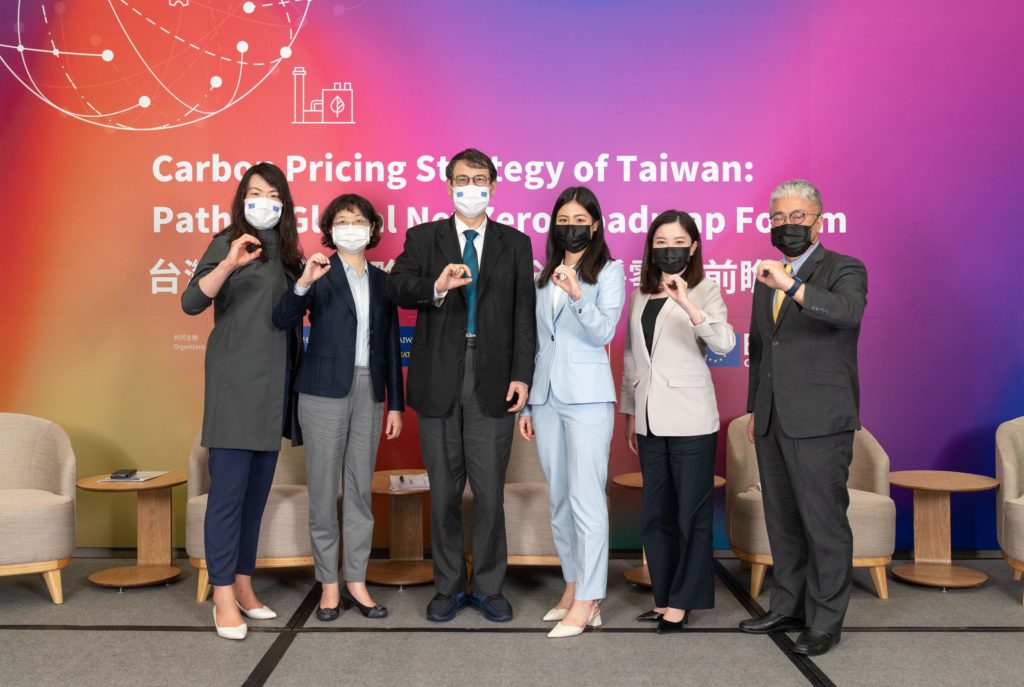
(L-R: Sammy Su, Director of ECCT LCI 歐洲商會-低碳倡議行動總監 蘇冬蘭; Dr. Tsai Ling-yi, Director-General of the Executive Yuan’s Office of Climate Change行政院環保署 氣候變遷辦公室主任 蔡玲儀博士; Dr Lin Tze-luen, Deputy Executive of the Office of Energy and Carbon Reduction 行政院能源及減碳辦公室副執行長 林子倫; Tracy Cheng, Climate & Energy Campaigner from Greenpeace Asia 綠色和平氣候能源專案主任 鄭楚忻; Faye Hsu, Manager of Corporate Sustainability Development Dept., Delta Electronics 台達電子企業永續發展部經理 許惠卿; Raime Chu, General Manager the Business Weekly Group 商周集團總經理 朱紀中)
